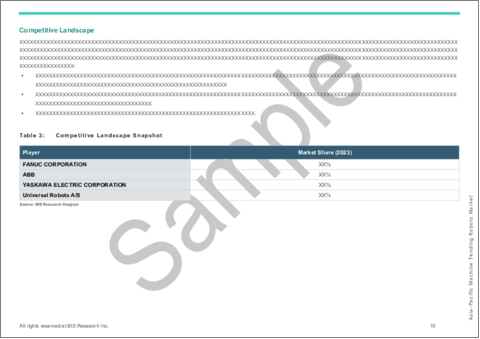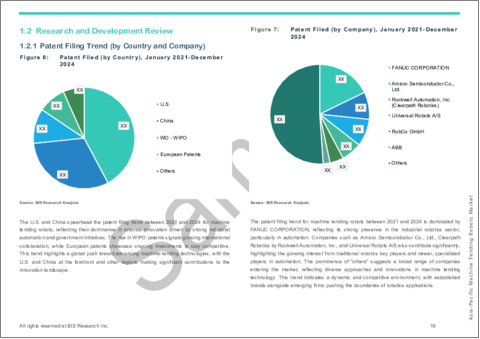|
|
市場調査レポート
商品コード
1752090
アジア太平洋のマシンテンディングロボット市場:用途別、最終用途産業別、ロボットタイプ別、国別 - 分析と予測(2024年~2034年)Asia-Pacific Machine Tending Robots Market: Focus on Application, Product Type, Country Analysis - Analysis and Forecast, 2024-2034 |
||||||
カスタマイズ可能
|
|||||||
| アジア太平洋のマシンテンディングロボット市場:用途別、最終用途産業別、ロボットタイプ別、国別 - 分析と予測(2024年~2034年) |
|
出版日: 2025年06月19日
発行: BIS Research
ページ情報: 英文 73 Pages
納期: 1~5営業日
|
全表示
- 概要
- 図表
- 目次
アジア太平洋のマシンテンディングロボットの市場規模は、2024年に67億1,558万米ドルとなりました。
同市場は、2034年には182億3,355万米ドルに達し、2024年から2034年の予測期間中に10.50%の堅調なCAGRを示すと予測されています。アジア太平洋のマシンテンディングロボット市場は、産業生産性の向上と運用コストの削減を目的とした自動化ニーズの高まりが主な要因となっています。労働力不足が深刻化し、反復作業により高い精度が求められるようになった結果、製造業者は洗練されたロボットソリューションを採用しています。特に、生産量の一貫性を高め、製造を合理化しようとする企業では、インテリジェントで適応性の高いシステムにより多くの資金が投資されています。センサー技術、AI主導の制御、マシンビジョンの開発が進むことで、よりインテリジェントで柔軟なマシンテンディング・アプリケーションが可能になりつつあります。これは、中国、日本、韓国、インドを含む国々の様々な産業における市場の力強い拡大に寄与しています。
| 主要市場統計 | |
|---|---|
| 予測期間 | 2024年~2034年 |
| 2024年の評価 | 67億1,558万米ドル |
| 2034年の予測 | 182億3,355万米ドル |
| CAGR | 10.5% |
市場イントロダクション
アジア太平洋のマシンテンディングロボット市場は、同地域のスマート・マニュファクチャリングへの移行、急速な工業化、労働力不足により大きく拡大しています。生産性の向上、運用コストの削減、職場の安全性の向上が期待できるため、CNCマシン、射出成形装置、その他の製造装置における部品のローディングとアンローディングを自動化するマシンテンディングロボットは、アジア太平洋でますます普及しています。
自動化、国内製造、技術革新を奨励する「"Made in China 2025"」やインドの生産連動型インセンティブ(PLI)制度のような政府プログラムが、中国、日本、韓国、インドが導入をリードするのに役立っています。中小企業(SME)は、当初は資本金が高額になることを懸念していましたが、現在では、モジュール式ソリューションや協働ロボット(cobot)が柔軟性と投資回収の早さを提供するため、徐々に受け入れられています。
人工知能(AI)、マシンビジョン、力制御の技術開発により、ロボットの知能と適応性が向上しました。これにより、消費者製品、エレクトロニクス、金属加工、自動車など、さまざまな産業への導入が可能になっています。アジア太平洋のマシンテンディングロボット市場は、高額な初期投資、統合の複雑さ、スキル格差といった障害にもかかわらず、安定した成長が見込まれています。この成長は、産業の近代化、有利な法規制、信頼性が高く精度の高い生産方式への需要の高まりによって後押しされるとみられています。
市場セグメンテーション
セグメンテーション1:用途別
- CNC機械加工
- 射出成形
- 研削・研磨
- 溶接
- 包装・仕分
- その他
セグメンテーション2:最終用途産業別
- 自動車
- 電子・半導体
- 金属・機械
- プラスチック・包装
- 消費財・食品加工
- その他
セグメンテーション3:ロボットタイプ別
- 多関節ロボット
- 直交ロボット
- スカラロボット
- デルタロボット
- その他
セグメンテーション4:国別
- 中国
- インド
- 日本
- 韓国
- オーストラリア
- その他
アジア太平洋のマシンテンディングロボット市場動向と促進要因・課題
市場動向
- 協働作用ロボット(コボット):CNCマシンやプレス機と並んで、軽量で人間にとって安全なコボットの導入が増加。
- AIとビジョンの統合:部品認識、品質検査、適応ハンドリングのための高度なマシンビジョンシステムとAIアルゴリズム。
- インダストリー4.0コネクティビティ:MES/ERPシステムとのシームレスな統合により、リアルタイムの性能監視と予知保全を可能にする。
- 柔軟な自動化セル:多様な部品サイズとマテリアルハンドリングに対応するモジュール式エンドオブアームツーリングとクイックチェンジフィクスチャー。
市場促進要因
- 労働力不足と賃金上昇:中国、日本、東南アジアの一部における労働市場の逼迫が、信頼性の高いロボットオペレーターの需要を押し上げている。
- 製造業の近代化:自動化を奨励する政府プログラム(「メイド・イン・チャイナ2025」、インドの生産連動インセンティブなど)。
- コストと品質へのプレッシャー:高精度機械加工におけるサイクルタイム、スクラップ率、ヒューマンエラーの削減の必要性。
- 小ロット・カスタム生産:エレクトロニクスと自動車における特殊製造業の成長により、柔軟なロボット・テンディング・ソリューションが推進されている。
市場の課題
- 高額な設備投資:ロボット、エンド・オブ・アーム・ツーリング、統合のための初期費用が中小企業の足かせとなっている。
- 統合の複雑さ:レガシーなマシン・インターフェースや多様な制御プロトコルが、シームレスな導入を複雑にしている。
- 熟練労働力の不足:システムの設置、プログラム、保守を行うオートメーション・エンジニアやロボット・プログラマーが不足している。
- 安全性とコンプライアンス:ロボットと人間の相互作用に関する地域別異なる基準により、個別の安全対策と認証が必要。
製品/イノベーション戦略:製品セグメントでは、市場で入手可能な様々なタイプのロボットの包括的な概要を提供し、独自の機能、性能特性、産業用途について詳述します。ロボットを多関節型、直交型、スカラ型、デルタ型、その他などのグループに分類することで、読者は各タイプが特定の操作要件にどのように対応し、製造効率を高めるかを把握することができます。このセグメンテーションは、最終的にアジア太平洋のマシンテンディングロボット市場における技術的多様性と競合情勢を理解するのに役立ちます。
成長/マーケティング戦略:アジア太平洋マシンテンディングロボット市場では、事業拡大、提携、協働、合弁など、市場参入企業による主な開拓が見られます。各社の戦略は、アジア太平洋マシンテンディングロボット市場での地位を強化するためのパートナーシップ、協業、合弁事業です。
競合戦略:本調査で分析・プロファイルしたアジア太平洋マシンテンディングロボット市場の主要企業には、高度な自動化ソリューションや統合ロボットシステムを開発する企業が含まれます。分析では、ロボットの種類、用途、地域、主要市場戦略の影響による市場セグメントをカバーしています。さらに、詳細な競合ベンチマーキングを実施し、競合企業の比較や市場情勢を明らかにしています。
主要市場参入企業と競合の要約
アジア太平洋のマシンテンディングロボット市場でプロファイルされている企業は、一次専門家から収集した情報に基づき、企業カバー率、製品ポートフォリオ、用途、市場浸透度の分析を通じて選定されています。
目次
エグゼクティブサマリー
第1章 市場:業界展望
- 動向:現状と将来への影響評価
- ロボット工学におけるAIとデジタル化
- 人間とロボットの協調と移動
- 自動化の民主化
- 研究開発レビュー
- 特許出願動向(国別・企業別)
- ステークホルダー分析
- 使用事例
- エンドユーザーと購入基準
- 市場力学の概要
第2章 地域
- 地域のサマリー
- アジア太平洋
- 地域概要
- 市場成長促進要因
- 市場成長抑制要因
- 中国
- 日本
- 韓国
- オーストラリア
- インド
- その他
第3章 市場-競合ベンチマーキングと企業プロファイル
- 今後の見通し
- 地理的評価
- 企業プロファイル
- FANUC CORPORATION
- Alfa Robot
- Seiko Epson Corporation
- OMRON Corporation
- YASKAWA ELECTRIC CORPORATION
- Kawasaki Heavy Industries, Ltd.
- Madox Technologies pvt. ltd.
第4章 調査手法
List of Figures
- Figure 1: Machine Tending Robots Market (by Region), $Million, 2023, 2028, and 2034
- Figure 2: Asia-Pacific Machine Tending Robots Market (by Application), $Million, 2023, 2028, and 2034
- Figure 3: Asia-Pacific Global Machine Tending Robots Market (by End-Use Industry), $Million, 2023, 2028, and 2034
- Figure 4: Asia-Pacific Global Machine Tending Robots Market (by Robot Type), $Million, 2023, 2028, and 2034
- Figure 5: Key Events
- Figure 6: Patent Filed (by Country), January 2021-December 2024
- Figure 7: Patent Filed (by Company), January 2021-December 2024
- Figure 8: End User and Buying Criteria
- Figure 9: Impact Analysis of Machine Tending Robots Market Navigating Factors, 2023-2034
- Figure 10: China Machine Tending Robots Market, $Million, 2023-2034
- Figure 11: Japan Machine Tending Robots Market, $Million, 2023-2034
- Figure 12: South Korea Machine Tending Robots Market, $Million, 2023-2034
- Figure 13: Australia Machine Tending Robots Market, $Million, 2023-2034
- Figure 14: India Machine Tending Robots Market, $Million, 2023-2034
- Figure 15: Rest-of-Asia-Pacific Machine Tending Robots Market, $Million, 2023-2034
- Figure 16: Data Triangulation
- Figure 17: Top-Down and Bottom-Up Approach
- Figure 18: Assumptions and Limitations
List of Tables
- Table 1: Market Snapshot
- Table 2: Opportunities across Regions
- Table 3: Competitive Landscape Snapshot
- Table 4: Trends: Current and Future Impact Assessment
- Table 5: Stakeholder Analysis
- Table 6: Machine Tending Robots Market (by Region), $Million, 2023-2034
- Table 7: Asia-Pacific Machine Tending Robots Market (by Application), $Million, 2023-2034
- Table 8: Asia-Pacific Machine Tending Robots Market (by End-Use Industry), $Million, 2023-2034
- Table 9: Asia-Pacific Machine Tending Robots Market (by Robot Type), $Million, 2023-2034
- Table 10: China Machine Tending Robots Market (by Application), $Million, 2023-2034
- Table 11: China Machine Tending Robots Market (by End-Use Industry), $Million, 2023-2034
- Table 12: China Machine Tending Robots Market (by Robot Type), $Million, 2023-2034
- Table 13: Japan Machine Tending Robots Market (by Application), $Million, 2023-2034
- Table 14: Japan Machine Tending Robots Market (by End-Use Industry), $Million, 2023-2034
- Table 15: Japan Machine Tending Robots Market (by Robot Type), $Million, 2023-2034
- Table 16: South Korea Machine Tending Robots Market (by Application), $Million, 2023-2034
- Table 17: South Korea Machine Tending Robots Market (by End-Use Industry), $Million, 2023-2034
- Table 18: South Korea Machine Tending Robots Market (by Robot Type), $Million, 2023-2034
- Table 19: Australia Machine Tending Robots Market (by Application), $Million, 2023-2034
- Table 20: Australia Machine Tending Robots Market (by End-Use Industry), $Million, 2023-2034
- Table 21: Australia Machine Tending Robots Market (by Robot Type), $Million, 2023-2034
- Table 22: India Machine Tending Robots Market (by Application), $Million, 2023-2034
- Table 23: India Machine Tending Robots Market (by End-Use Industry), $Million, 2023-2034
- Table 24: India Machine Tending Robots Market (by Robot Type), $Million, 2023-2034
- Table 25: Rest-of-Asia-Pacific Machine Tending Robots Market (by Application), $Million, 2023-2034
- Table 26: Rest-of-Asia-Pacific Machine Tending Robots Market (by End-Use Industry), $Million, 2023-2034
- Table 27: Rest-of-Asia-Pacific Machine Tending Robots Market (by Robot Type), $Million, 2023-2034
- Table 28: Market Share, 2023
This report can be delivered in 2 working days.
Introduction to Asia-Pacific Machine Tending Robots Market
The Asia-Pacific machine tending robots market, valued at $6,715.58 million in 2024, is expected to reach $18,233.55 million by 2034, exhibiting a robust CAGR of 10.50% during the forecast period 2024-2034. The market for machine tending robots in the APAC region is mostly driven by the growing need for automation to increase industrial productivity and reduce operating costs. Manufacturers are adopting sophisticated robotic solutions as a result of growing labour shortages and the need for more precision in repetitive activities. More money is being invested in intelligent, adaptable systems, particularly as firms look to increase output consistency and streamline manufacturing. More intelligent and flexible machine tending applications are being made possible by ongoing developments in sensor technology, AI-driven controls, and machine vision. This is contributing to the strong market expansion across a variety of industries in nations including China, Japan, South Korea, and India.
| KEY MARKET STATISTICS | |
|---|---|
| Forecast Period | 2024 - 2034 |
| 2024 Evaluation | $6,715.58 Million |
| 2034 Forecast | $18,233.55 Million |
| CAGR | 10.5% |
Market Introduction
The market for machine tending robots in Asia-Pacific (APAC) is expanding significantly due to the region's ongoing transition to smart manufacturing, fast industrialisation, and labour shortages. Because they may increase productivity, lower operating costs, and improve workplace safety, machine tending robots-which automate the loading and unloading of parts in CNC machines, injection moulding units, and other manufacturing equipment-are becoming more and more popular in Asia-Pacific.
Government programs like """"Made in China 2025"""" and India's Production Linked Incentive (PLI) schemes, which encourage automation, domestic manufacturing, and innovation, are helping China, Japan, South Korea, and India lead the adoption. Small and medium businesses (SMEs), who were initially apprehensive because of the high capital needs, are now progressively embracing modular solutions and collaborative robots (cobots) since they provide flexibility and a quicker return on investment.
Robot intelligence and adaptability have been improved by technological developments in artificial intelligence (AI), machine vision, and force control. This has enabled deployment in a variety of industries, including consumer products, electronics, metalworking, and automotive. The market for APAC machine tending robots is expected to grow steadily despite obstacles such high initial investment, integration complexity, and skills gaps. This growth will be aided by industrial modernisation, advantageous legislation, and the growing demand for reliable, highly accurate production methods.
Market Segmentation:
Segmentation 1: by Application
- CNC Machine Tending
- Injection Molding
- Grinding and Polishing
- Welding
- Packaging and Sorting
- Others
Segmentation 2: by End-Use Industry
- Automotive
- Electronics and Semiconductors
- Metal and Machinery
- Plastics and Packaging
- Consumer Goods and Food Processing
- Others
Segmentation 3: by Robot Type
- Articulated Robots
- Cartesian Robots
- SCARA Robots
- Delta Robots
- Others
Segmentation 4: by Country
- China
- India
- Japan
- South Korea
- Australia
- Rest-of-Asia-Pacific
APAC Machine Tending Robots Market Trends, Drivers and Challenges
Market Trends
- Collaborative Robots (Cobots): Increasing deployment of lightweight, safe-for-human cobots alongside CNC machines and presses.
- AI & Vision Integration: Advanced machine-vision systems and AI algorithms for part recognition, quality inspection and adaptive handling.
- Industry 4.0 Connectivity: Seamless integration with MES/ERP systems, enabling real-time performance monitoring and predictive maintenance.
- Flexible Automation Cells: Modular end-of-arm tooling and quick-change fixtures to handle diverse part sizes and materials.
Market Drivers
- Labor Shortages & Rising Wages: Tightening labor markets in China, Japan and parts of Southeast Asia boosting demand for reliable robot operatives.
- Manufacturing Modernization: Government programs (e.g., "Made in China 2025", India's Production Linked Incentive) incentivizing automation.
- Cost & Quality Pressures: Need to reduce cycle times, scrap rates and human error in high-precision machining.
- Small-Batch & Custom Production: Growing specialty manufacturing in electronics and automotive driving flexible robot tending solutions.
Market Challenges
- High Capital Investment: Upfront costs for robots, end-of-arm tooling and integration deter smaller SMEs.
- Integration Complexity: Legacy machine interfaces and diverse control protocols complicate seamless deployment.
- Skilled Workforce Gap: Shortage of automation engineers and robot programmers to install, program and maintain systems.
- Safety & Compliance: Varying regional standards for robot-human interaction requiring tailored safety measures and certifications.
How can this report add value to an organization?
Product/Innovation Strategy: The product segment provides a comprehensive overview of the various robot types available in the market, detailing their unique functionalities, performance characteristics, and industrial applications. Categorizing robots into groups such as articulated, Cartesian, SCARA, delta, and others enables readers to grasp how each type caters to specific operational requirements and enhances manufacturing efficiency. This segmentation ultimately aids in understanding the technological diversity and competitive landscape within the APAC machine tending robots market.
Growth/Marketing Strategy: The APAC machine tending robots market has seen major development by key participants operating in the market, such as business expansion, partnership, collaboration, and joint venture. The favored strategies of the companies have been partnership, collaboration, and joint venture activities to strengthen their position in the APAC machine tending robots market.
Competitive Strategy: Key players in the APAC machine tending robots market analyzed and profiled in the study include companies developing advanced automation solutions and integrated robotics systems. The analysis covers market segments by distinct robot types, applications served, regional presence, and the impact of key market strategies. Additionally, detailed competitive benchmarking has been conducted to illustrate how players compare, providing a clear view of the market landscape.
Key Market Players and Competition Synopsis
The companies profiled in the Asia-Pacific machine tending robots market have been selected based on inputs gathered from primary experts and through an analysis of company coverage, product portfolio, application, and market penetration.
Some of the prominent names in this market are:
- FANUC CORPORATION
- Alfa Robot
- Seiko Epson Corporation
- OMRON Corporation
- Madox Technologies Pvt. Ltd.
Table of Contents
Executive Summary
Scope and Definition
1 Market: Industry Outlook
- 1.1 Trends: Current and Future Impact Assessment
- 1.1.1 AI and Digitalization in Robotics
- 1.1.2 Human-Robot Collaboration and Mobility
- 1.1.3 Democratization of Automation
- 1.2 Research and Development Review
- 1.2.1 Patent Filing Trend (by Country and Company)
- 1.3 Stakeholder Analysis
- 1.3.1 Use Case
- 1.3.2 End User and Buying Criteria
- 1.4 Market Dynamics Overview
- 1.4.1 Market Drivers
- 1.4.1.1 Labor Shortages and Cost Pressures
- 1.4.1.2 Productivity, Throughput, and Quality Imperatives
- 1.4.1.3 Technological Advancements and Industry 4.0 Initiatives
- 1.4.2 Market Challenges
- 1.4.2.1 High Initial Investment and ROI Concerns
- 1.4.2.2 Technical Complexity and Skills Gap
- 1.4.2.3 Integration and Process Constraints
- 1.4.3 Market Opportunities
- 1.4.3.1 Untapped Industries and SMEs
- 1.4.3.2 Advancements in Technology and Service Models
- 1.4.3.3 Global Supply Chain Reconfiguration and Resilience Strategies
- 1.4.1 Market Drivers
2 Regions
- 2.1 Regional Summary
- 2.2 Asia-Pacific
- 2.2.1 Regional Overview
- 2.2.2 Driving Factors for Market Growth
- 2.2.3 Factors Challenging the Market
- 2.2.3.1 Application
- 2.2.3.2 Product
- 2.2.4 China
- 2.2.4.1 Application
- 2.2.4.2 Product
- 2.2.5 Japan
- 2.2.5.1 Application
- 2.2.5.2 Product
- 2.2.6 South Korea
- 2.2.6.1 Application
- 2.2.6.2 Product
- 2.2.7 Australia
- 2.2.7.1 Application
- 2.2.7.2 Product
- 2.2.8 India
- 2.2.8.1 Application
- 2.2.8.2 Product
- 2.2.9 Rest-of-Asia-Pacific
- 2.2.9.1 Application
- 2.2.9.2 Product
3 Markets - Competitive Benchmarking & Company Profiles
- 3.1 Next Frontiers
- 3.2 Geographic Assessment
- 3.3 Company Profiles
- 3.3.1 FANUC CORPORATION
- 3.3.1.1 Overview
- 3.3.1.2 Top Products/Product Portfolio
- 3.3.1.3 Top Competitors
- 3.3.1.4 Target Customers
- 3.3.1.5 Key Personnel
- 3.3.1.6 Analyst View
- 3.3.1.7 Market Share, 2023
- 3.3.2 Alfa Robot
- 3.3.2.1 Overview
- 3.3.2.2 Top Products/Product Portfolio
- 3.3.2.3 Top Competitors
- 3.3.2.4 Target Customers
- 3.3.2.5 Key Personnel
- 3.3.2.6 Analyst View
- 3.3.2.7 Market Share, 2023
- 3.3.3 Seiko Epson Corporation
- 3.3.3.1 Overview
- 3.3.3.2 Top Products/Product Portfolio
- 3.3.3.3 Top Competitors
- 3.3.3.4 Target Customers
- 3.3.3.5 Key Personnel
- 3.3.3.6 Analyst View
- 3.3.3.7 Market Share, 2023
- 3.3.4 OMRON Corporation
- 3.3.4.1 Overview
- 3.3.4.2 Top Products/Product Portfolio
- 3.3.4.3 Top Competitors
- 3.3.4.4 Target Customers
- 3.3.4.5 Key Personnel
- 3.3.4.6 Analyst View
- 3.3.4.7 Market Share, 2023
- 3.3.5 YASKAWA ELECTRIC CORPORATION
- 3.3.5.1 Overview
- 3.3.5.2 Top Products/Product Portfolio
- 3.3.5.3 Top Competitors
- 3.3.5.4 Target Customers
- 3.3.5.5 Key Personnel
- 3.3.5.6 Analyst View
- 3.3.5.7 Market Share, 2023
- 3.3.6 Kawasaki Heavy Industries, Ltd.
- 3.3.6.1 Overview
- 3.3.6.2 Top Products/Product Portfolio
- 3.3.6.3 Top Competitors
- 3.3.6.4 Target Customers
- 3.3.6.5 Key Personnel
- 3.3.6.6 Analyst View
- 3.3.6.7 Market Share, 2023
- 3.3.7 Madox Technologies pvt. ltd.
- 3.3.7.1 Overview
- 3.3.7.2 Top Products/Product Portfolio
- 3.3.7.3 Top Competitors
- 3.3.7.4 Target Customers
- 3.3.7.5 Key Personnel
- 3.3.7.6 Analyst View
- 3.3.7.7 Market Share, 2023
- 3.3.1 FANUC CORPORATION
4 Research Methodology
- 4.1 Data Sources
- 4.1.1 Primary Data Sources
- 4.1.2 Secondary Data Sources
- 4.1.3 Data Triangulation
- 4.2 Market Estimation and Forecast






